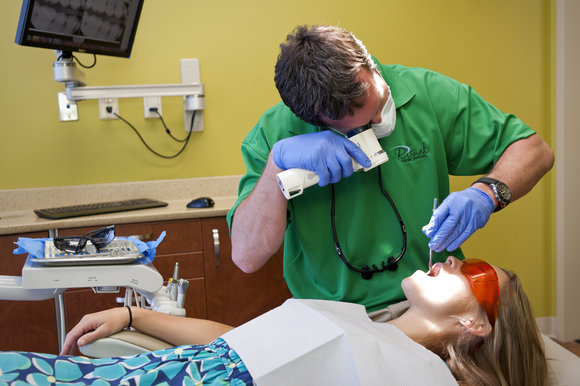The Future of Dental Technology and What It Means For You as a Patient
Picture this: You go in for your scheduled dental checkup and discover you have a cavity. But instead of a long process that involves drilling into your tooth, your dentist shoots a laser beam into your mouth, and then injects a paste. Voila! Your tooth is fixed.
Seem like a science fiction movie about dentists? This scenario is actually not too far-fetched. The future of dental technology is bringing revolutionary new oral health techniques that will turn dental appointments into quick and painless visits. Here are a few of the latest dental technologies that are expected to change the world of dental medicine.
Lasers In Dentistry
Dental lasers are not a new technology. In fact, using lasers in dentistry has been around since the early 90’s. With new developments and easier production in recent years, these lasers are now more prevalent in the field of dentistry. Some dental schools even offer courses in laser dentistry, paving the way for the use of lasers in the future of dentistry.
What does this mean for you?
Less time and pain! These modern lasers are virtually pain-free, removing the need for numbing injections or pastes. They also can be quicker than the standard drills currently used in dentistry.
Regenerating Teeth
Once decay sets in, a tooth has been compromised structurally. Although you can remove decayed tissue, the dentist has to fill it with either a composite or amalgam substance to prevent bacteria from continuously eroding the tooth structure. However, this process may be a thing of the past. Dentists have created a new process that uses electrical currents to re-mineralize decaying tooth areas. Though still a few years away from being widely available, this exciting discovery could change the face of dental medicine altogether.
What does this mean for you?
No more fillings. If successful, this technology could eradicate the need for fillings altogether, allowing the decaying tooth structure to organically heal itself.
Cancer-Detecting Ultraviolet Lights
Approved by the FDA, ultraviolet handheld devices can now be used by dentists to detect oral cancer in its earliest stages. This system uses fluorescent light to show any irregular cells in the mouth that may be signs of oral cancer. The VELscope system is non-invasive and only takes about two minutes to work, which means it can be used during your routine dental exams.
What does this mean for you?
Traditionally, oral cancer had a mortality rate of about 50% due to it being a cancer that was typically not detected until it was already in an advanced stage. Using this new UV device, these cancers can be caught earlier on, saving lives and preventing them from spreading.
Digital Dentistry
Instead of x-rays using focused radiation in film production, dentists are now more commonly using digital x-rays. These digital systems provide instantaneous imaging for the doctors, as well as producing 90% less radiation than the standard film method.
Another digital system being used in dentistry is the intraoral digital camera. This camera has a built-in light source and is small enough to be comfortably used on patients. With zooming capabilities and snapshot features, the intraoral digital camera can get a close look at every tooth, and can even store or print images for your file. Best of all, these cameras provide dentists and hygienists with one of the best tools for diagnosing problems in the mouth.
What does this mean for you?
Digital technology is emerging as a game-changer in dentistry. Primarily, it makes it easier for your dentist to detect cavities and gum disease. It also cuts down on the use of radiation in dentistry. Rusnak Family Dentistry has been on the cutting age of embracing digital dentistry and uses intraoral cameras and digital x-rays on all patients.
3-D Printed Teeth
3-D printing has provided many breakthroughs for the medical community, but the benefits seen in dentistry will be immeasurable. One example of these benefits is the process of dental crowns. The current process involves taking a cast, making a temporary crown, and sending off the cast to a lab for the production of the permanent crown. In the future 3-D printing will expedite this process.
What does this mean for you?
By using 3-D printing technology, dentists may be able to streamline the dental crown process. This would hopefully mean that crowns could be manufactured more quickly and perhaps less expensively.
So will this science fiction story become a reality? Within the next few years, the implementation of even a few of the technologies listed above would completely alter the field of dentistry. The future of dental technology will bring many exciting changes for dentists and oral surgeons, but for patients the upsides are simple: Less time, money, and discomfort. Constantly evolving technologies are changing the face of dentistry, making the dread of an uncomfortable dentist appointment a thing of the past.


4 Comments
Lauren
We live in a very exciting time, especially when it comes to the future of dental technology. Anything that has to do with less time and pain are all positive factors in improving the overall atmosphere at a dental office.
Delores Lyon
Wow, it is so cool that there are so many new developments in the dental field! Just the fact that lasers are being used to treat and clean teeth is amazing! I’d love to see for myself what laser dentistry is like- I might just have to start looking for a dentist in my area who has laser technology. Hopefully I can find a dentist that will do a good job!
Jamarcus Dantley
I had no ideas that you could use certain types of lasers on your teeth. I like that it takes less time and causes less pain than regular dentistry. It seems like it will be a great thing for the future!
Ethel
It is so cool that lasers can be used to regenerate teeth! Making fillings a thing of the past would be extremely innovative! Being able to use lasers in dentistry to detect cancer before it happens is amazing. Thanks for sharing all this interesting information. I learned quite a bit.